Repointing Comber Northern Ireland (BT23): The time will arrive to do a bit of maintenance on your dwelling in Comber, whatever age your property happens to be. Homes and buildings in Comber are hit by all sorts of pollution, weather and other adverse factors that may have an adverse effect on the condition of the mortar or cement between the brickwork, and should you discover evidence of this you might have to call someone. The best solution is to hire a brick repointing specialist in Comber, to keep your home watertight and get your tatty brickwork back into pristine condition.
The bricks and mortar are what make a building sufficiently strong enough to withstand the elements. To keep a home dry and warm the mortar has to be in sufficiently good condition to stop any draughts and damp from forcing its way in through holes or gaps. But how can you tell whether or not your brickwork needs to be repointed?
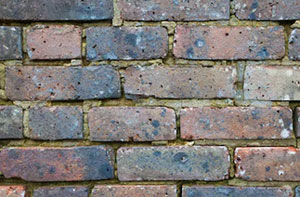
Quite simply, you need to have a good look at the condition of the mortar and bricks of your exterior walls. If you discover damage or sections which look distinctly different to the remainder of the property, you may want to speak to a local repointing contractor for a more thorough inspection. It may be necessary to bring in an expert to inspect hard to reach areas like chimneys or under eaves, but in many buildings you should be able to spot any signs of deterioration fairly easily.
You also need to consider the issues of safety that crumbling or damaged mortar joints could potentially cause. The integrity of any Comber home is only as effective as its bricks and mortar. Any weakness in the structural integrity can render a building unstable with major consequences and risk to life.
It may be a situation where damaged or impaired brickwork is the primary reason behind any eroding or missing mortar that you discover on your house. It's crucial that you employ a reputable brick repointing company in Comber, so that they can repair or replace any defective areas of brickwork before the repointing is carried out. This will guarantee the perfect finish to your home, with no nasty surprises down the line.
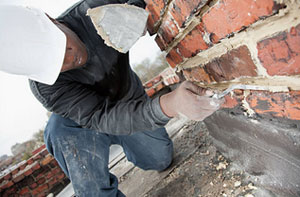
To help in safeguarding the brickwork, lots of buildings in Comber had their external walls plasterered over or painted. It might suggest complications with the brickwork or mortar allowing damp into the walls, if you discover indications of bubbling, flaking or other deterioration in painted or rendered brickwork. Inspection of this problem, by a professional contractor is the only safe way to make sure the damage does not spread more widely and cause structural problems as time goes on. By employing a reputable and qualified repointing specialist you will keep your exterior walls in the best condition possible.
WHAT STEPS ARE REQUIRED FOR REPOINTING BRICKWORK IN COMBER?
Repointing takes quite a bit of time to complete correctly and will entail working at considerable height in a lot of cases. When you speak to a repointing specialist, the very first thing that they will need to do is carry out an eyes-on inspection of the structure, so they can evaluate the amount of work that's needed and the magnitude of any damages areas. This will enable them to supply you with an itemised quote for renovation project. Always obtain 2 or 3 quotations and don't always assume cheapest is best.
It might be that during the initial site survey there were some parts of your house that were hard to reach or inaccessible and in cases like this a second, more thorough survey might be needed. It's quite possible that this more comprehensive survey might expose further issues that could increase the original quote. The older a house is, the higher chance that it will require some restorative work, and for properties that were built more than sixty years ago, this is especially true.
Reparation work can commence once the problems have been uncovered. So as to have a stable platform while renovating your home, the likelihood is that a repointing contractor will need to have a scaffold built. An arrangement of protective shielding or sheeting will then be attached to the outside of the scaffold. This might be plastic sheeting to collect any dirt and debris that's generated during the repairs.
Pipes and wires may need to be removed or adjusted to permit access to the brickwork behind them. As soon as the repointing work has been accomplished these components can all be fixed back into their original positions.
If the brickwork on your house in Comber is pebble-dashed, painted or rendered, such decorative coverings will need to be removed to enable access to the bare brick surfaces. The brickwork behind such outer coverings will be sanded and cleaned to ensure a uniform finish for your exterior walls.
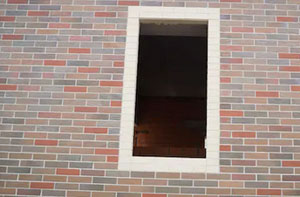
If you've not decided on a a pointing style (Tuck, Flush, Weather Struck or Recessed pointing), or you wish to see how the various pointing methods look on your home, a decent Comber repointing company will be glad to produce a test panel on your property. This will help you to get an idea of the finished result and guarantee your satisfaction with the finished product with regard to style and colour.
The next phase is to remove the old, crumbling mortar by raking and cleaning out the joints in the brickwork. This can be quite a laborious procedure where any debris, dust and old mortar has to be painstakingly removed to provide a good bonding surface for the new mortar. Special attention is made around doors and windows since any movement in the brickwork can lead to problems with their closing and opening.
When the joints are clean, the brickwork should be damped down to help stop the fresh mortar from drying out too rapidly and ultimately cracking. The delayed drying time stops the mortar from becoming inflexible and cracking, which can bring about a weakened joint. When it is sufficiently dry it's time to clean off any smears and excess mortar from the surrounding brickwork. The team will work on the brickwork in sections, cleaning each one in turn before moving on to a new patch.
If any brick replacement, chimney repairs or lead flashing work needs doing by the repointing company as part of the project, now is the time that these tasks will be carried out.
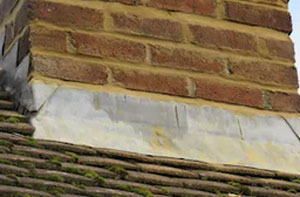
Any paint, rendering or other wall coverings that you need will be applied once all the repointing work has been completed. The final phase of the project will see all cables, pipes and other fixtures put back into their original positions, scaffolding and work platforms dismantled and all building waste removed and disposed of.
An established Comber repointing and brick repair specialist will provide a restoration that will last as long as sixty years. They should also offer you a warranty for their work and be backed by professional qualifications and accreditation in the building and construction industry.
Suitable accreditations may take various forms, but the ones that stand out with regards to repointing are: the National House Building Council (NHBC), the National Federation of Building Contractors (NFBC) and the Federation of Master Builders (FMB), with certifications and qualifications from building industry leaders such as the Chartered Institute of Building. Every person who works on repointing and repairing your brickwork should also be signed up to the Construction Skills Certification Scheme and be willing to verify their skills and ability by producing an appropriate CSCS card.
You should have no problem finding repointing specialists in Comber, and adjacent places such as: Carrowdore, Saintfield, Greyabbey, Carryduff, Balloo, Dundonald, Crossnacreevy, Lisbane, Moneyreach, Ballygowan, Killinchy, Millisle, Newtownards. Areas with postcodes like BT23 5GX, BT23 5AZ, BT23 5BA, BT23 5WE, BT23 5UW, BT23 5AU, BT23 5QW, BT23 5PB, BT23 5JL, and BT23 5HW are also covered. If they've got the telephone dialling code 028 and the postcode BT23, it is probable that they hail from Comber or somewhere close by.
Brick Cleaning Comber
The process of brick cleaning involves eliminating muck, grime, and various stains from the brick wall's surface. The bricks on a building may lose their colour and become unpleasant to look at over time, due to the weather and pollution. By restoring the bricks to their original texture and colour, brick cleaning can enhance the building's aesthetic appeal.
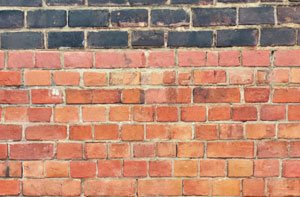
For brick cleaning, there are a range of methods to choose from, including sandblasting, chemical cleaning and pressure washing. The sort of stains and the condition of the bricks will dictate the method used for cleaning. The safety and effectiveness of the brick cleaning process are paramount, and it is recommended to hire a specialist company with the necessary expertise in the field.
In addition to improving the overall appearance of the structure, brickwork cleaning can also have practical benefits. By cleaning bricks, it is possible to decrease their ability to absorb water, which can ultimately prevent the formation of mould and damp. It's important to choose a brick cleaning contractor that takes environmental factors into consideration, such as the products and methods used during the process. Additionally, a detailed quote and timeline from the brick cleaning company are essential to enable homeowners to plan and budget accordingly for the project.
Ridge Tile Repointing Comber
Ridge tiles and mortar joints should be inspected at least every other year. Repointing cracks in mortar joints can prevent leaking roofs and expensive re-roofing work in Comber. Be extra vigilant with ridge tiles because they are exposed to the extremes of the weather from all sides and may exhibit mortar cracks before other tiles on the roof. If you discover cracks in the mortar between ridge tiles, the options are rebed the ridge tile or repoint the joints.
If the cracks are minor and the tile appears to be securely bedded, repointing the mortar is a suitable option. If the cracks in the mortar are as wide as the mortar joint and the ridge tile seems to have some movement, it would be better to rebed the whole tile rather than repointing. If you repoint a tile that is no longer securely bedded, the repair isn't going to last very long and the crack will quickly reoccur.
Of course, at times a ridge tile needs to be rebedded instead of repointed which requires a little more work. Again, ensure that you take all safety precautions whilst working at height. Use a hammer and chisel to remove the mortar as well as the ridge tile. Use the chisel and hammer to remove the mortar from the bed on the roof, and mortar from the underside of the ridge tile. As soon as the ridge tile is off, replacing the ridge iron is sensible, particularly if there is any evidence of rust. Remove any organic matter such as moss or mould and use a fungicide to make sure the area is protected in the future. Then soak the area in water while mixing mortar. Mix a stiff mortar in a ratio of 3:1 (sharp sand: cement). Dampen the tile and roof as you work. Put mortar onto both sides of the tile and use a trowel to lay a bed of mortar on the roof. Place the tile on the mortar bed and firmly press down. Remove any mortar that oozes out between joints. Make sure the joint gaps are filled, and smooth joints with pointing trowel.
The integrity of the roof protects your greatest investment from damages resulting from weather in Comber. Checking and repointing your roof before cracks permit water to penetrate into your house, are simple ways to save money.
Tuckpointing Comber
Exactly What is Tuck Pointing? Tuckpointing is a method of repointing old and battered brickwork where the mortar is crumbling and unstable. It's purpose is to accentuate the cosmetic appearance of walls, giving the illusion that they're well maintained and in a much better state than they actually are.
A portion of the crumbling, old mortar is removed and this is replaced with a coloured mortar that's as close as possible to the colour of the stone or brick from which the wall is built. A narrow contrasting line of lighter mortar is then inserted to make it appear like the joints are even and neat, where in fact the joints are in fact wide and irregular in width.
Particularly when seen from a distance, the effect of tuck-pointing can be quite remarkable, and without doing any major renovations, can substantially enhance the overall look of a wall. (Tags: Tuckpointing Comber, Tuck Pointing Comber, Tuckpointing Mortar Joints Comber).
Chimney Repointing
Chimneys are often overlooked in relation to property maintenance, but a chimney that's showing signs of decay can be an expensive issue. During an initial assessment of your chimney in Comber, a specialist may recommend repointing or perhaps even a complete rebuild of your chimney, dependant upon the size of the damaged and affected area. Professional chimney repointing will restore the integrity of your chimney by replacing the old, crumbling mortar with new material. This should forestall the need for a complete chimney rebuild and give you many more years of peace of mind. Chimney repointing also prevents damage to the inside surfaces of your chimney stack, by preventing moisture from seeping through the gaps and cracks in the mortar. Most recently constructed chimneys are steel lined and if this liner comes into contact with moisture, it reduces its lifespan. Once repointing work has been finished, an external sealant should be applied which repels water and allows the release of any internal moisture.
Brick Crack Stitching
Brick crack stitching is a process used to repair cracks in brick buildings and structures. In order to reinforce the affected area's mortar bed and provide extra support to the structure, stainless steel rods are inserted and held in place with a special grout. The aim of this technique is to reinforce the weakened brickwork and prevent further cracking by providing extra support and stability. This process utilizes flexible steel rods that can move with the structure and absorb any extra stress, providing stability and reinforcement to the vulnerable brickwork. The crack stitching process can be applied to numerous structures, including bridges, chimneys, tunnels and walls, for the purpose of repairing cracks and enhancing structural stability. The application of this process offers a straightforward and efficient solution to a typical problem in brickwork structures and can result in a significant extension of the structure's longevity. This approach is a versatile and cost-effective option for repairing both contemporary and historic buildings, and is frequently chosen over other solutions due to its non-invasive nature and affordability.
Mortar Colour Matching
The fine details are what make masonry structures, especially older or historical ones, aesthetically pleasing and structurally sound. One detail that stands apart among these for its significance is mortar colour matching. To the untrained eye, mortar colour matching might seem like a minor aspect, but it is a necessary part of any brickwork restoration project to professionals and purists.
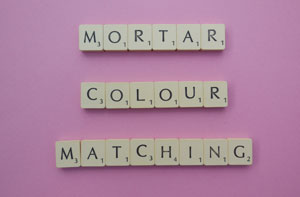
Mortar is used to bind bricks, stones, or other masonry units together in the context of masonry. It enhances the structure's aesthetic appeal while also providing structural integrity. The combined effect of bricks and mortar is what gives a brick wall its unique character. Therefore, a disparity in mortar colour can drastically affect the overall look of a structure, therefore it's essential to match the mortar colour carefully.
The seamless blending of new mortar with pre-existing mortar is essential during the repair or renovation of buildings. In cases like this, mortar colour matching becomes extremely important, and involves a mixture of art and science. Maintaining uniformity guarantees that the building retains its original aesthetic appearance, making it appear as though no work has been done at all - an ideal outcome in renovation projects.
It may seem simple at first, but finding the correct colour match is actually more difficult. Important considerations include:
- Binders: The colour of the mortar is partly determined by binding materials like lime and cement. Adjusting how much of these materials are used can subtly adjust the shade of the mortar.
- Sand: The specific granularity, type and colour of sand in the mortar mixture are central to its resulting colour. The variation in sand shades across different regions necessitates the careful selection of the right kind of sand.
- Additives: Additives in modern mortar mixtures, ranging from chemicals for enhanced durability to advanced colouring agents, can all play a role in determining the mortar's final colour.
Mortar can undergo a colour change due to environmental conditions like moisture, pollution in the air and temperature fluctuations over time. So, the procedure entails not merely aligning with the mortar's original colour but also foreseeing the ageing process of the new mortar in contrast to the old.
The benefits of mortar colour matching go beyond mere appearance. Problems like differential settling or thermal movement may ensue if the mortar's composition and strength are not matched. As time passes, this might impair the structural stability of the building. (88253 - Mortar Colour Matching Comber)
Repointing Specialists Near Comber
Also find: Newtownards repointing, Ballygowan repointing, Carryduff repointing, Carrowdore repointing, Greyabbey repointing, Balloo repointing, Millisle repointing, Lisbane repointing, Killinchy repointing, Saintfield repointing, Moneyreach repointing, Crossnacreevy repointing, Dundonald repointing and more. There are builders who do repointing in just about all of these villages and towns. These skilled specialists bring a wealth of expertise and knowledge to the table, ensuring that your repointing project is executed to perfection. Considering professional intervention is advisable if you're dealing with brickwork that looks old and shabby, to help set it right. By clicking here, repointing quotes are available to local property owners.
Comber Repointing Tasks
Just Some of the Tasks That a Repointing Specialist Can Do

There is a wide range of work that can be conducted by your local Comber repointing specialist including the replacement of damaged brickwork in Comber, lintel replacement, stone cleaning in Comber, restorations to damaged brickwork, stone strengthening in Comber, repointing of brickwork, ridges repointed or rebedded in Comber, mortar raking Comber, masonry restoration, ribbon pointing and repointing Comber, gable end repointing Comber, mortar rake grinding Comber, brickwork crack stitching in Comber, bed joint reinforcement Comber, brick joint restoration, the repointing and pointing of brickwork, stone wall repointing, chimney repointing Comber, lime mortar repointing Comber, fireplace repointing Comber, pebbledash removal, valley repointing, repairs to cracks in brickwork Comber, porch repointing, brick & mortar tinting, brickwork crack repairs, repointing services, chimney repairs, repointing crazy paving Comber, lead valleys renewed or repaired, brick cleaning, repointing paving, tile repointing, pointing and re-pointing mortar joints, brick foundation repointing Comber, and repointing scaffolding. Listed are just a few of the tasks that are undertaken by experts in brick repointing. Comber providers will tell you about their entire range of services.
More: Brickwork Sealing, Mortar Repointing, Patio Repointing, House Repointing, Brick Repointing, Residential Repointing, Brickwork Sealing, Residential Repointing, Roof Repointing, Brickwork Cleaning, Repointing Specialists, Brick Cleaning, Repointing Services, Mortar Raking, Mortar Repointing, Repointing, Patio Repointing, Brickwork Repointing, Repointing, Mortar Repointing, Wall Repointing, House Repointing, Mortar Repointing, Repointing, Chimney Repointing, Brick Repointing, Repointing, Mortar Raking, House Repointing, Patio Repointing, Brick Cleaning, Pointing, Pointing, Patio Repointing, Chimney Repointing.
By county/region: West Midlands, Bedfordshire, Cheshire, Dorset, Norfolk, Greater London, Devon, East Yorks, Northumberland, East Sussex, Powys, Northern Ireland
Repointing Quotations Comber - Repointing Brick Walls Comber - Chimney Repointing Comber - Repointing Mortar Joints Comber - Repointing Near Me - Brick Repointing Comber - Repointing Patios Comber - Brickwork Repointing Comber - Repointing Comber


